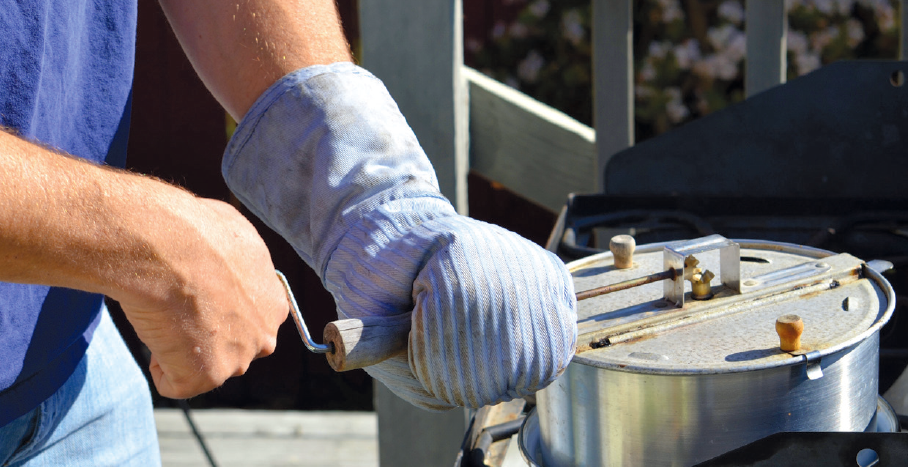How to Roast Coffee Beans at Home
Roasting coffee at home?
You can do that?
I had no idea until about 10 years ago when a dinner party host tossed some Papua New Guinea peaberry green coffee beans into a small pan and roasted them in the outdoor pizza oven still blazing-hot from dinner. In no time, the rock-hard, raw green beans transformed into bronzed baubles. It was a revelation. And after tasting coffee freshly brewed from these just-roasted beans, I was hooked.
Drink in these stories from three others who are equally passionate about home roasting.
NOAH THOMAS of Ventura started home-roasting coffee about three years ago, an extension of his ongoing interest in food preparation and technology.
“I have been interested in what I call the lost arts of daily food prep for a while and started with the usual routes of DIY food exploration— sourdough starters, vegetable ferments—and then got into seed oil prep and coffee roasting,” he says.
Thomas honed his coffee roasting using very basic, inexpensive equipment: a repurposed Whirley Pop stovetop popcorn maker, a skillet (used to diffuse the heat), a propane stove and some large metal sieves/colanders. The whole setup cost him about $30, and he is very happy with the quality of the roasts, as well as the volume that he can roast at one time.
“For the method I use, I like that I have to rely on the senses of smell and hearing to obtain the roasts that I want. I don’t use a temperature gauge because I am more into the art or phenomenological side of things than the experimental science part of it.”
To learn more, I watch Thomas as he roasts a batch of Sumatran beans. As promised, he doesn’t look at the beans at all as he roasts. Instead, as he operates the hand crank on the Whirley Pop, he’s concentrating on the sound of the beans as they roast. He’s listening for the beans to “crack” and he’s taking in the roasting beans’ aromas. Suddenly, with a knowing look, he exclaims, “OK, they should be perfect!”
Next he pours the beans into one of the large colanders he uses for cooling and removing the beans’ chaff (papery specks released by the beans during roasting; they don’t affect the coffee’s flavor but are messy and generally removed.)
“It is pretty easy to lean the basic skills, and the jump in quality from store-bought coffee is remarkable. Plus, I’m totally addicted to coffee,” he says.
His two favorite coffees for feeding his cravings?
“I tend to like the two extremes of the fruity Ethiopian dry-processed beans and the dark earthiness of Sumatran or Javan beans. My method of roasting isn’t very subtle, so I think these beans allow me to get great flavor profiles in a wide range of roasts.”
For Newbury Park resident RON HIRSTY, the best cup of coffee starts with home-roasted beans and is served in a ceramic mug handcrafted by his wife, Judy.
He has home-roasted coffee sporadically for the past couple decades, using everything from steel pans to a popcorn popper. But for the last two years he has roasted regularly, driven by a desire to experience really fresh roasted coffee.
“Roasting coffee may seem like a hassle for some, but it’s part of my Saturday morning ritual,” says Hirsty. “I usually do my coffee roasting while I stretch or warm up for my Saturday morning tai chi. By the time my coffee is roasted, I’m ready for a more intense workout.”
Not a fan of automatic machines or processes, Hirsty uses an inexpensive hot air roaster from Fresh Beans Inc. The Fresh Roast SR500 coffee roaster does have some automatic functionality, but Hirsty intervenes. He gauges the beans’ roast level by color, and uses a flashlight to help him more accurately see the hue. (He likes the beans a rich, dark brown.)
His coffee paraphernalia also includes an enthusiast-level grinder, manual Italian espresso machine, Chemex brewer and French presses.
He likes that home roasting enables him to “tune a type of coffee to your own palate and experience some incredible coffee flavors.”
He currently favors coffees from Congo and Yemen, all Fair Trade and from small growers, while Hirsty’s wife loves small-crop Colombian coffee.
GREEN COFFEE BEANS
If you want to start home-roasting coffee, seek out green beans from these local businesses:
Moore Coffee, Tea & Spices
Ventura
Nearly 20 varieties from around the globe.
MooreCoffee.com
Bean Crazy Coffee
Thousand Oaks
A rotating selection of up to four varieties.
805.371.7171
To see more photos from these home-roasting sessions, visit EdibleVenturaCounty.com.
TRACEY RYDER (Co-founder of Edible Ojai and Edible Communities)
Q: When did you start home-roasting coffee?
A: 2009
Q: Why?
A: I started as an attempt to be fully sustainable with my home pantry. I make all condiments from scratch and store everything in glass containers and grind my own corn for masa/tortillas, etc., so I felt coffee was a natural extension of what I was already doing.
Q: What equipment do you use?
A: HotTop Basic Roaster and a stovetop Whirley Pop popcorn maker.
Q: Your favorite bean?
A: I use beans from places that are closest to the U.S. so that it’s as “local” as possible. I often roast Kona beans from Hawaii or Mexico Organic La Lagunilla.




